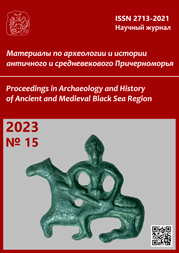Археологические данные к локализации крепости Билистан
Archaeological evidence for the localization of the Bilistan fortress
Author(s): Murtazali Gadjiev, M.Sh. Saypudinov, V.A. Saidov, Yu.A. MagomedovSubject(s): History, Archaeology, 6th to 12th Centuries
Published by: Нижневартовский государственный университет
Keywords: Dagestan; Lakz; Bilistan; Arab conquests; Marwan ibn Muhammad; Arbis ibn Basbas; Kuysun fortified settlement;
Summary/Abstract: The article deals with the localization of the Bilistan fortress, which, according to the authoritative Arab historian Ibn A’tham al-Kufi (d. 926), was besieged by Arab troops led by the governor of Arminiyya Marwan ibn Muhammad in 120 AH / 738 CE during the conquest campaigns in the East Caucasus and in which the king of Lakz Arbis ibn Basbas took refuge. According to al-Kufi’s Kitāb al-futūḥ (The Book of Conquests), this fortified settlement was located in the Land of Lakz in the middle reaches of the Samur River. In 2019, a hypothesis based on a linguistic-etymological and toponymic analysis was proposed by one of the authors of this article, according to which this historically attested site could be located in the middle reaches of the Samur River, in the area of the modern-day village of Kuysun. Discovered here in 2023, a settlement with a fortified citadel as well as the ceramic material collected there enable the dating of the site to the 6th — 8th century. Hence, there is a strong argument for localizing the Bilistan fortress exactly where the recently discovered Kuysun settlement is situated.
Journal: Материалы по археологии и истории античного и средневекового Причерноморья
- Issue Year: 2023
- Issue No: 15
- Page Range: 509-528
- Page Count: 20
- Language: Russian

